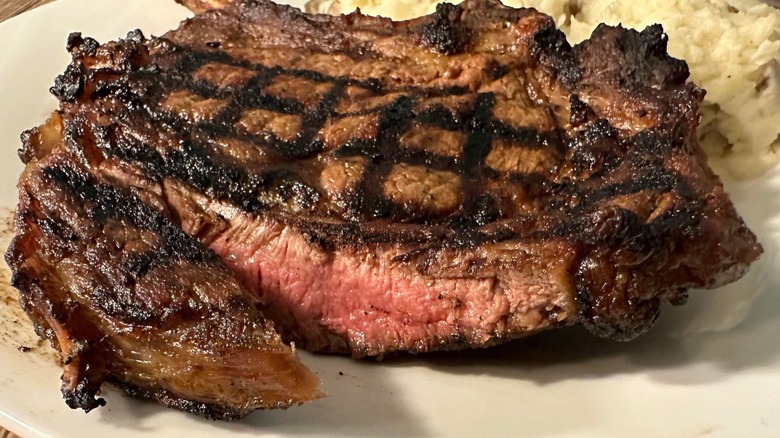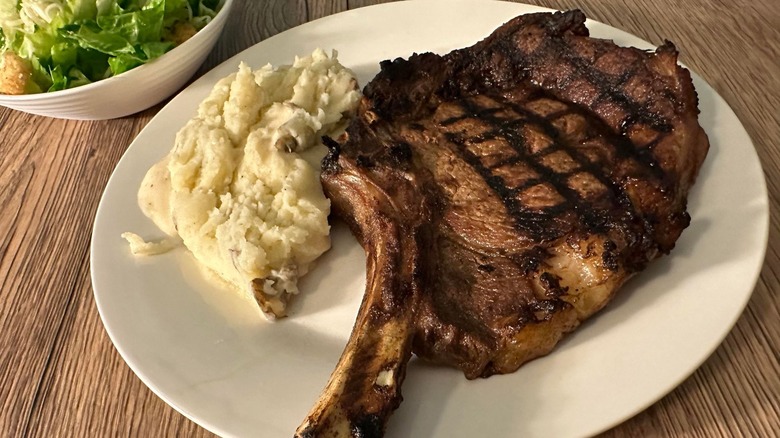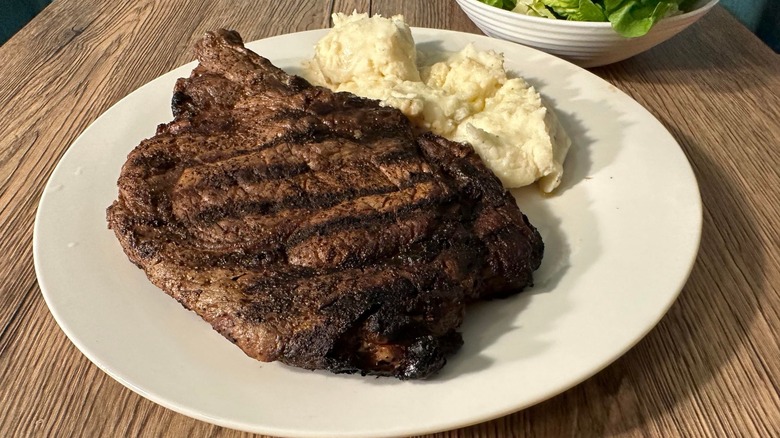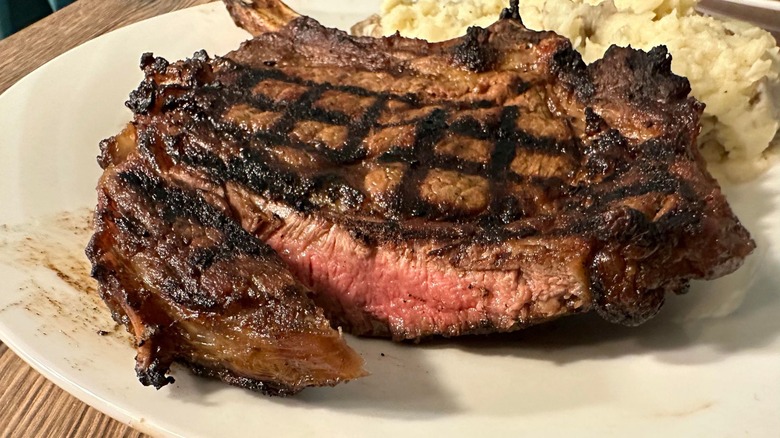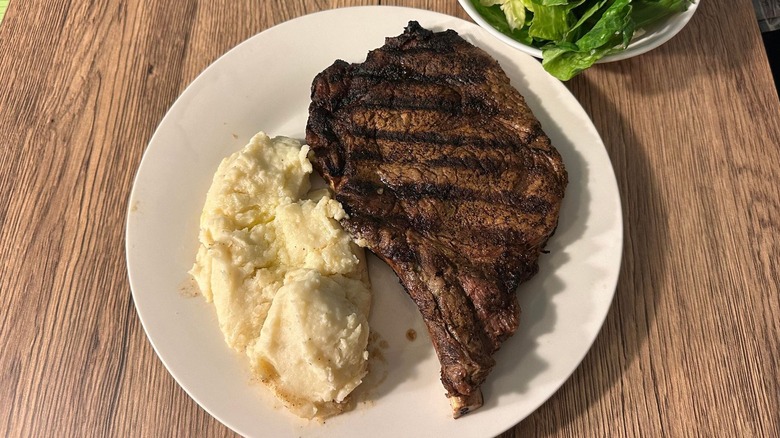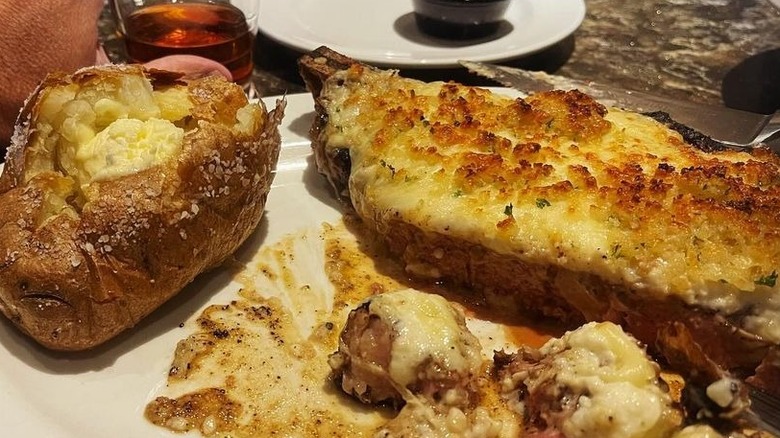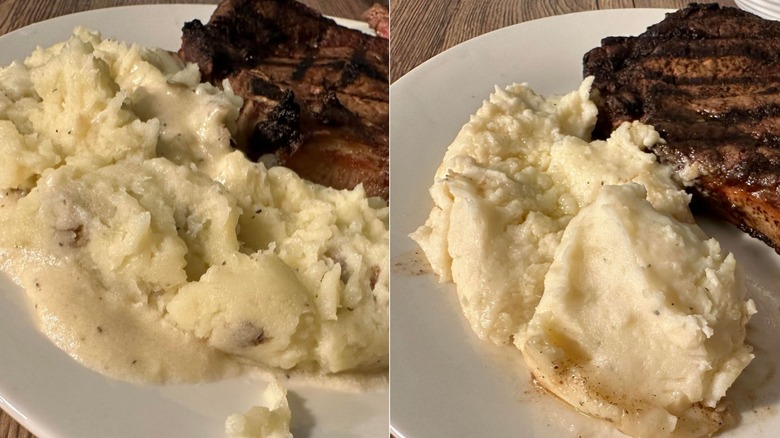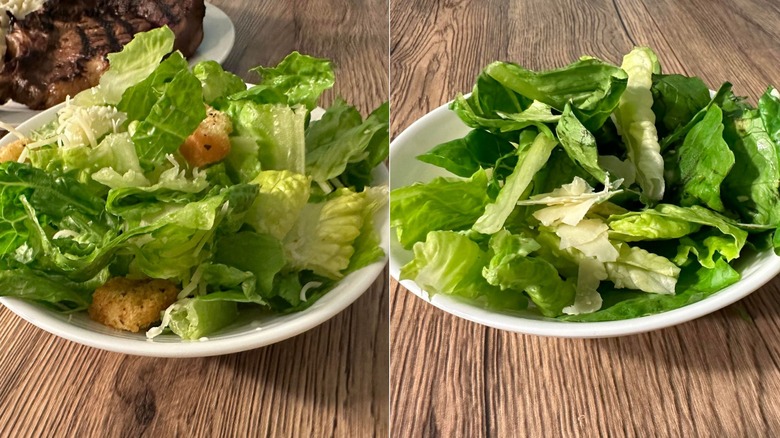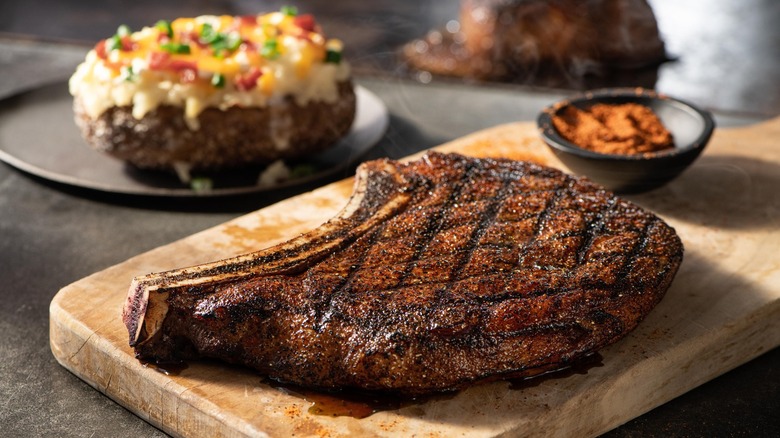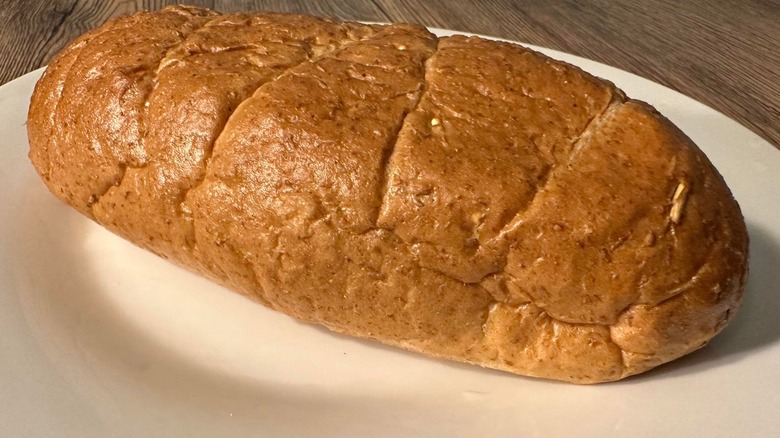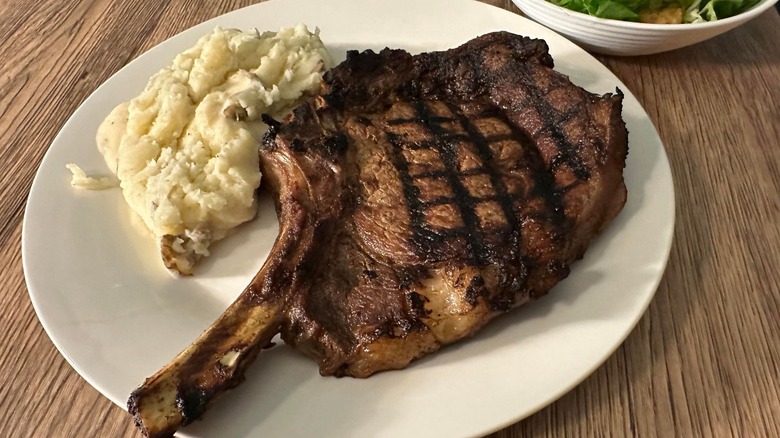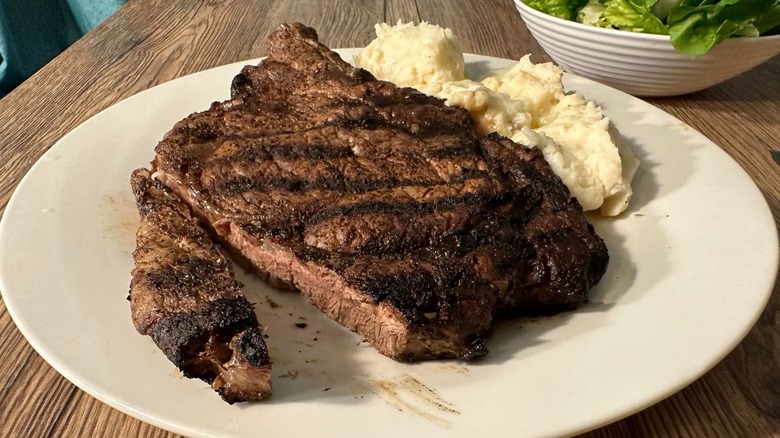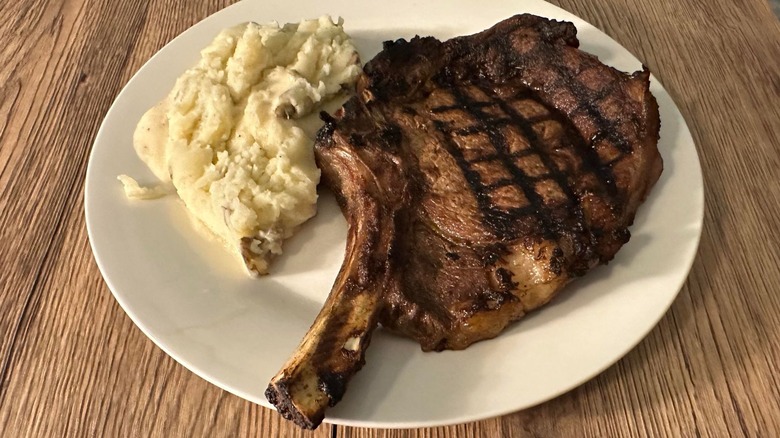Bone-In Ribeye At Texas Roadhouse Vs LongHorn Steakhouse: Which Is Best?
As more and more restaurant chains have tried to appeal to a higher class of foodie, some may find it tricky to decide where to eat when looking for a solid steak meal. While there once used to be just a few well-known steakhouse chains, it now seems like a new one is popping up daily. Any given region is likely to have multiple chain restaurants serving thick, juicy, tender steaks of high quality, and two of the biggest at the moment are Texas Roadhouse and LongHorn Steakhouse.
While both establishments offer similar steaks, I'll be focusing on each restaurant's version of a classic bone-in ribeye. Traditionally cooked on a hot skillet, there are many reasons why ribeye is a favorite of Michelin chefs. But the bone-in ribeye is a little bit different. The thick cut of steak with the bone still present makes it a delicious meal and a sight to behold on your plate. LongHorn and Texas Roadhouse have received good reviews for their bone-in ribeyes, but that wasn't enough; I wanted to judge them for myself. And my results may surprise you. I assessed more than just the ribeye, including the menu options provided for the entree, sides, and more. Which one came out on top? Read on to find out.
The price
Ordering a thick, juicy steak is never going to be easy on the wallet, and that's doubly true for ribeyes, which ranked #1 on our list of best cuts of steak. Ordering the bone-in ribeye entree from both Texas Roadhouse and LongHorn Steakhouse doesn't offer any significant discount in that regard, and the prices are perfectly in line with what would be expected for a meal of this size and quality. That said, it's worth noting that I purchased both meals at locations situated in Southeast Pennsylvania, and prices may vary somewhat by region. Nevertheless, Roadhouse's Bone-in Ribeye ran $29.99 with no toppings or add-ons, while LongHorn Steakhouse's Outlaw Ribeye set me back $30.79.
The difference, a total of just 80 cents, might be noticeable if we were talking about a fast food meal of a few dollars. But when ordering a steak dinner, that difference is almost not worth mentioning and shouldn't be much of a deciding factor when determining which option is better or the right choice for you. That said, those who are budget-conscious will always take a little savings where they can on comparable dishes — should they be equivalent. So while the winner here may be Texas Roadhouse by sheer mathematics, it won't make much difference in your opinion of the meal.
Size and value
A question any steak-lover has to ask before digging into a bone-in ribeye is whether the portion served is worth the hefty price tag. At $30 or more, the meal isn't for those looking to skimp on a night out, so it's important to know if you're getting your money's worth. So who offers the better value: Texas Roadhouse or LongHorn Steakhouse? Once again, it all depends on which one wins our head-to-head quality matchup later, because as it stands, the two versions of the meal are all but identical in size.
Both the Texas Roadhouse Bone-in Ribeye steak and the Outlaw Ribeye from LongHorn are listed as 20-ounce portions. LongHorn's description states that its version is a "marbled cut of bone-in ribeye ... coated with our smoky Char Seasoning and fire-grilled." Texas Roadhouse provides a simpler description, listing the 20-ounce size and promising "extra flavor." Because both are so similar, the crux of this showdown will be decided almost entirely by which one provides the better overall experience, most notably the taste and texture (but I'll dive into that a little later).
Appearance and overall impression
Appearance and overall impression are an important component of a meal at a quality steakhouse when you're dining out for the evening. Though it's not the be-all-end-all, it's been shown that a good-looking meal can alter the perception of food, making it a more enjoyable experience and even improving the taste through psychological conditioning. Thus, the look and feel of these two steaks is important, make no mistake.
The LongHorn steak is definitely appealing at first look, with tough, evenly spaced grill marks across its surface and a lot of delectable meat that is pleasing to the eye. The Texas Roadhouse ribeye, by contrast, has a criss-cross checkerboard grill pattern, and the large bone protruding from the end makes it appear like an idealistic version of the dish. The Roadhouse ribeye is also noticeably shinier, more visibly moist, and juicier than its LongHorn counterpart, and as a result, it certainly appears more appealing, even downright mouth-watering.
Cutting into each steak reveals the differences in doneness. Both were ordered medium, which should have a pink center throughout. Though the Texas Roadhouse entree appeared visibly pink when I cut into it, the LongHorn Outlaw Ribeye was missing that colorful hue, appearing more like it was cooked medium well. There were even spots in the LongHorn steak that seemed nearly well done. As a result, I have to give the Texas Roadhouse steak a clear edge here as the doneness more closely matches what was requested.
Overall taste and flavor
Though I've already touched on the steaks' appearances, it's also worth noting that LongHorn's website advertises its ribeye with checker pattern grill marks, but the one I received only had solid lines. Certainly, nothing to complain about, but the mismatch from the advertised imagery may leave those focused on appearance a tad disappointed. With that said, both steaks are delicious with a strong flavor and pleasant texture, never too soft nor too tough, with just the right amount of seasoning.
Nevertheless, this is no tie; there's an easy winner here and it might surprise some, mostly because it's not very close. The Texas Roadhouse ribeye simply has a more robust flavor and is far juicier than LongHorn's, with visible moisture flowing forth when cut. It's just as juicy in every bite too, which matches up with the steak's more accurate cook level and pink center. Though both have a lot of flavor, the LongHorn steak could have used a little sauce to bring it out further, while the Texas Roadhouse ribeye had all the flavor it needed on its own. For those looking to replicate the experience at home, check out our tutorial on how to cook a ribeye steak to sizzling perfection to see if you can match that flavor.
Available add-on options
For the purposes of our comparison, I opted for identical ribeye offerings, with no add-ons or optional toppings. Still, the availability of various accouterments is important in evaluating each restaurant's ribeye, as the variety of choices can make a huge difference based on personal tastes. And this is where LongHorn may get some points to make up for its lagging score. The Outlaw Ribeye offers up a nice selection of options, including a Parmesan crust (for an additional $1.99), grilled shrimp ($6.99), grilled lobster tail ($11.79), and seasoned mushrooms ($3.49).
Texas Roadhouse also provides a decent menu of options for its bone-in ribeye. The available add-ons include sauteed mushrooms and onions ($2.79), a bleu cheese crumble ($0.79), a topping of three grilled shrimp ($3.99), and extra Jack cheese ($0.50). Though the range of cost offers more choices at lower price points, the difference probably isn't a huge factor when ordering a ribeye. For the more budget-conscious stripe, Roadhouse may be the preferred destination, but the option of lobster tail and Parmesan crust are just special enough to earn LongHorn a much-needed win.
Mashed potatoes
While the menus at both restaurants offer a variety of choices, I chose two side dishes that are synonymous with steak and are available as sides at just about any steakhouse one could imagine: mashed potatoes and a Caesar salad. These two choices also offer a good comparison because they are so ubiquitous that we all know what to look for and what to expect for a satisfying version of both. So how did these two simple sides stack up?
Admittedly, the quality of the ribeye is going to be the deciding factor in your choice of steak, but the sides matter too, and both deliver. Neither version will impress you as anything special that you might find at a more gourmet restaurant, but they are definitely a step up from the store-bought variety. Both boast plenty of flavor but they also have their pros and cons. For starters, the Texas Roadhouse mashed potatoes have a better texture thanks to the inclusion of small bits of potato skins and a thicker consistency. By comparison, the LongHorn mashed potatoes are a tad runnier than ideal and come across as a little too simple.
While the difference between them isn't huge, Texas Roadhouse once again gets the win. If you're interested in whipping up your own version of this one, check out our rundown of the best mashed potato recipes.
Caesar Salad
In addition to mashed potatoes, I chose a Caesar salad as the second side dish. Though you might expect all Caesar salads to be created equal — after all, it's mostly just lettuce — the two were surprisingly dissimilar. LongHorn Steakhouse's salad was evenly cut with fresh green lettuce and some sliced Parmesan. Despite the website's promise of croutons, none were present, which was a pretty big letdown as they would have offered a little more crunch and flavor.
On the flip side, Texas Roadhouse's side salad lettuce didn't feel quite as lush, but still tasted fresh. The presence of a healthy serving of croutons was a big step up, and the larger offering of grated cheese (in this case a more common mixed blend) helped provide a more varied flavor profile that prevented it from becoming too bland. I opted for ranch dressing on both, and the two opposing dressings provided were fairly comparable. That makes another marginal win for Texas Roadhouse, which is coming out ahead in most categories so far.
Other side options
Like the add-ons available for the ribeye, it's important to discuss what sides are offered besides the two I chose for a side-by-side comparison. Each restaurant provides diners with a long list to choose from, starting with the Caesar salad and mashed potatoes. Beyond those two is a wide variety of potential dishes. LongHorn presents several different salad options alone, with a mixed green salad and strawberry salad in addition to the Caesar.
After salads, LongHorn's side menu also includes seasoned rice, sweet potato, corn on the cob, Brussels sprouts, shrimp lobster chowder, steakhouse mac & cheese, fries, broccoli, loaded baked potatoes, and asparagus, as well as onion or loaded potato soup. Over at Texas Roadhouse, there's a similar menu with a few key differences. Diners can choose a baked potato, buttered corn, Caesar salad, house salad, mac & cheese, mashed potatoes, seasoned rice, broccoli, fries, and sweet potato. It also offers applesauce, sauteed onions, and sauteed mushrooms.
All told, LongHorn gets the win when it comes to sides. In addition to having more choices than Texas Roadhouse, its offerings are also a bit more varied, and the shrimp lobster chowder and strawberry salad stand out as a couple of particular highlights.
Complimentary bread and butter
Most steakhouse patrons aren't coming for the free bread, but the complimentary pre-appetizer snack is still an integral part of the meal as it sets the stage for everything that comes next. It can be a solid palate cleanser before the more flavorful food and help diners bide their stomach's appetite while they wait for the main course.
As for LongHorn and Texas Roadhouse's offerings, this comparison makes for an easy decision, as one bread was far better, tastier, and fresher. That winner would be LongHorn Steakhouse with its luscious, tasty loaf of honey wheat bread made from a house recipe. Texas Roadhouse's bread was stiffer and far sweeter — so sweet that I was almost prompted to spit out the single bite I took.
The upside for Texas Roadhouse is that its butter beat the competition. I got two containers of cinnamon butter and a portion of real soft whipped fresh butter. LongHorn, sadly, only provided two pre-packed single pats of a very generic-tasting salted butter. Both LongHorn and Texas Roadhouse made our list of steakhouse chains with the absolute best free bread according to customers, so it's possible I simply got a bad batch here.
The winner is ...
There are many criteria to consider and elements to examine when deciding who wins our contest of bone-in ribeye steaks from LongHorn Steakhouse and Texas Roadhouse. From appearance, texture, and taste to the quality of the sides and the available menu options, there's a lot to look at. But when all is said and done there is one winner: Texas Roadhouse. This might surprise some, as LongHorn is a dedicated steakhouse and Texas Roadhouse is more of a general grill-style restaurant with burgers, sandwiches, and chicken dishes.
Nevertheless, between the fact that Roadhouse's Bone-in Ribeye easily bested LongHorn's Outlaw Ribeye in flavor and appearance and that its salad also took home a win makes it an easy decision. Though it suffered a few losses, I can't hold it against the Roadhouse ribeye that the complimentary bread wasn't up to snuff or that the side dish menu wasn't as strong. After all, customers looking for a ribeye review probably aren't as concerned with the free loaf or the side salad; it's all about the cut of beef, how it's cooked, and how tender it tastes. And with that, Texas Roadhouse's Bone-in Ribeye easily takes home the coveted crown in what some may have expected to be a tough head-to-head matchup.
Recommendations
Even though Texas Roadhouse wins our contest against LongHorn Steakhouse, that doesn't mean I'm automatically telling readers to choose that establishment when looking for a bone-in ribeye. Sure, my experience — an at-home, takeout dinner to ascertain which one was better — deemed Texas Roadhouse tastier, but there is still more to consider and my ultimate recommendation is a bit more nuanced.
For starters, you'll likely eat your bone-in ribeye at the restaurant as a dine-in experience, perhaps with a loved one, friends, or family. And that's where things get tricky. Texas Roadhouse, for example, is a more family-friendly chain. It has an alcohol menu, but the energy is more vibrant and meant to appeal to all ages. While LongHorn Steakhouse is certainly not unwelcome to children and families, the general atmosphere is somewhat more refined and perhaps more appropriate for a classy, romantic evening or even a business dinner with colleagues.
I can definitely recommend Texas Roadhouse's bone-in ribeye over LongHorn's Outlaw Ribeye. But the fact that both are solid versions of the meal means that you might be happier at LongHorn depending on what kind of dining experience you are looking for. If it's purely about the food, go with Texas Roadhouse, but if you want a certain kind of night out, there's every reason to choose LongHorn Steakhouse.
Our methodology for deciding which is better
Comparing two identical entrees is no easy task, so to grade each, I looked at the same criteria that the most seasoned, expert food critics consider when evaluating a proper steak. Traditionally, critics grade a good steak on five key elements: doneness (how properly it's cooked, typically judged by its color throughout as well as its tenderness and juiciness), appearance, overall impression, taste, and texture.
For evaluation purposes, I went solely by my own opinion and what I felt stood out most from each meal. This includes the steak itself, the sides, and the assorted options on the menu. Still, I shared the meal with a companion, and after providing my analysis, I found that with a few minor differences of opinion, my take was generally in line with what my dining partner felt as well. This gave me confidence that my impression was likely shared by others, and made me comfortable with handing down my review to you, the dear reader.
